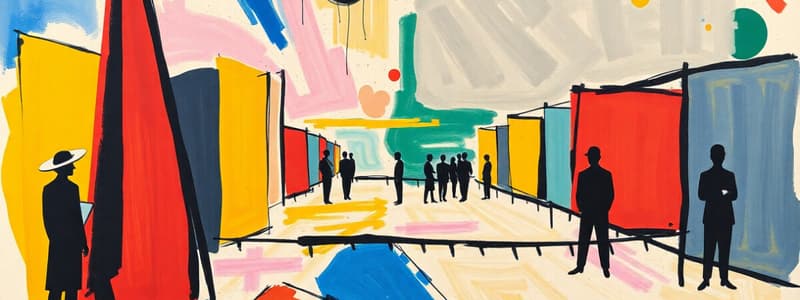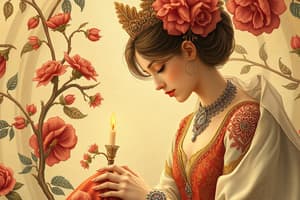Podcast
Questions and Answers
What was highlighted at the 1900 Exposition Universelle in Paris?
What was highlighted at the 1900 Exposition Universelle in Paris?
- Installation art
- Video art
- Conceptual pieces
- Traditional academic art (correct)
Which of the following were common subjects in art around 1900?
Which of the following were common subjects in art around 1900?
- Portraiture (correct)
- Digital formats
- Abstract expressionism
- Conceptual art
Modern art in 2000 included traditional painting and sculpture.
Modern art in 2000 included traditional painting and sculpture.
False (B)
Who is considered a central figure in modernism?
Who is considered a central figure in modernism?
What major art movement emerged post-World War II?
What major art movement emerged post-World War II?
What concept did Marcel Duchamp introduce with 'readymades'?
What concept did Marcel Duchamp introduce with 'readymades'?
Which theorist argued for a broader understanding of modernism?
Which theorist argued for a broader understanding of modernism?
What did postmodern artists like Rauschenberg and Johns blur the lines between?
What did postmodern artists like Rauschenberg and Johns blur the lines between?
In modernity, Baudelaire emphasized the __________ nature of modern life.
In modernity, Baudelaire emphasized the __________ nature of modern life.
What were the common subjects in art at the 1900 Exposition Universelle in Paris?
What were the common subjects in art at the 1900 Exposition Universelle in Paris?
Modern art in 2000 included traditional painting and sculpture.
Modern art in 2000 included traditional painting and sculpture.
Who is credited as the father of postmodernism?
Who is credited as the father of postmodernism?
Modernity refers to the experience of living in a rapidly changing, ______ world.
Modernity refers to the experience of living in a rapidly changing, ______ world.
Which of the following was a notable artist mentioned as a representative of modern art in 2000?
Which of the following was a notable artist mentioned as a representative of modern art in 2000?
What significant artistic movement emerged in America after World War II?
What significant artistic movement emerged in America after World War II?
Clement Greenberg believed art should be influenced by external narratives.
Clement Greenberg believed art should be influenced by external narratives.
Match the following artists with their contributions to art:
Match the following artists with their contributions to art:
Flashcards are hidden until you start studying
Study Notes
Introduction: Art in 1900 and 2000
- The 1900 Exposition Universelle in Paris featured art from 29 countries, emphasizing traditional academic forms, particularly classical styles from the Renaissance.
- Common genres displayed included history painting, portraiture, landscapes, still life, and nudes, with avant-garde movements like Impressionism present but subordinate to traditional art.
- In contrast, the 2000 Tate Modern showcased installations, video art, and conceptual pieces, marking a significant evolution in artistic expressions.
- Key artists of the time included Damien Hirst, Rachel Whiteread, and Tracey Emin, demonstrating a shift to abstract and conceptual art forms.
The Challenge of Writing Art History
- The diverse and rapid evolution of 20th-century art complicates the writing of its history, challenging historians to define its scope.
- Avant-garde movements such as Romanticism, Realism, and Impressionism broke from classical traditions, paving the way for new media like installations and digital art.
- A debate exists among art historians on whether to focus solely on traditional forms (painting and sculpture) or to embrace experimental art practices.
Modernity and Modernism
- Modernity, as introduced by Charles Baudelaire, expresses the experiences of living in a dynamic, urbanized environment and emphasizes the transitory nature of modern life.
- Impressionist artists like Pissarro and Delacroix exemplified modernity by capturing fleeting moments through their innovative use of color and form.
- Modernism signifies art’s response to modern life, prioritizing autonomy, leading figures like Pablo Picasso to explore new boundaries in painting and sculpture.
- Important movements under this banner include Abstract art and Cubism, which eschewed realistic representation for form and color exploration.
Avant-Garde vs. Tradition
- Avant-garde movements actively challenged traditional artistic practices, advocating for radical ideas such as abstraction and the use of commonplace objects in art.
- Marcel Duchamp is recognized as a pioneer of postmodernism due to his "readymades," which interrogated the definition and boundaries of art itself.
- There is a complex relationship where avant-garde movements simultaneously opposed and were influenced by traditional art discourses.
Mid-20th Century: From Modernism to Postmodernism
- Following World War II, Abstract Expressionism emerged in America, with figures like Jackson Pollock emphasizing internal emotional expression and the painting process.
- By the late 1960s, a shift occurred toward Postmodernism, introducing minimalism, Pop Art, and conceptual art that challenged established definitions of art.
- Artists like Andy Warhol and Donald Judd utilized industrial materials and consumer culture themes, moving away from modernist ideals of unique individual expression.
Theoretical Shifts in Art Criticism
- Clement Greenberg, a prominent critic, defended modernism, advocating that art should prioritize its own medium, focusing on flatness and form in painting.
- Greenbergian Modernism emphasizes art's autonomy, detached from external narratives or real-world depictions.
- Critics like Rosalind Krauss argued against Greenberg’s formalism in the 1970s, promoting a broader interpretation of modernism and contributing to the emergence of postmodern theory.
Postmodernism and Contemporary Art
- Postmodern artists, including Robert Rauschenberg and Jasper Johns, blurred the lines between art and life, integrating everyday objects and materials into their works.
- Rauschenberg's Combine Paintings serve as a seminal example of postmodernism, merging painting and sculpture with non-traditional elements.
Introduction: Art in 1900 and 2000
- The 1900 Exposition Universelle in Paris featured art from 29 countries, emphasizing traditional academic forms, particularly classical styles from the Renaissance.
- Common genres displayed included history painting, portraiture, landscapes, still life, and nudes, with avant-garde movements like Impressionism present but subordinate to traditional art.
- In contrast, the 2000 Tate Modern showcased installations, video art, and conceptual pieces, marking a significant evolution in artistic expressions.
- Key artists of the time included Damien Hirst, Rachel Whiteread, and Tracey Emin, demonstrating a shift to abstract and conceptual art forms.
The Challenge of Writing Art History
- The diverse and rapid evolution of 20th-century art complicates the writing of its history, challenging historians to define its scope.
- Avant-garde movements such as Romanticism, Realism, and Impressionism broke from classical traditions, paving the way for new media like installations and digital art.
- A debate exists among art historians on whether to focus solely on traditional forms (painting and sculpture) or to embrace experimental art practices.
Modernity and Modernism
- Modernity, as introduced by Charles Baudelaire, expresses the experiences of living in a dynamic, urbanized environment and emphasizes the transitory nature of modern life.
- Impressionist artists like Pissarro and Delacroix exemplified modernity by capturing fleeting moments through their innovative use of color and form.
- Modernism signifies art’s response to modern life, prioritizing autonomy, leading figures like Pablo Picasso to explore new boundaries in painting and sculpture.
- Important movements under this banner include Abstract art and Cubism, which eschewed realistic representation for form and color exploration.
Avant-Garde vs. Tradition
- Avant-garde movements actively challenged traditional artistic practices, advocating for radical ideas such as abstraction and the use of commonplace objects in art.
- Marcel Duchamp is recognized as a pioneer of postmodernism due to his "readymades," which interrogated the definition and boundaries of art itself.
- There is a complex relationship where avant-garde movements simultaneously opposed and were influenced by traditional art discourses.
Mid-20th Century: From Modernism to Postmodernism
- Following World War II, Abstract Expressionism emerged in America, with figures like Jackson Pollock emphasizing internal emotional expression and the painting process.
- By the late 1960s, a shift occurred toward Postmodernism, introducing minimalism, Pop Art, and conceptual art that challenged established definitions of art.
- Artists like Andy Warhol and Donald Judd utilized industrial materials and consumer culture themes, moving away from modernist ideals of unique individual expression.
Theoretical Shifts in Art Criticism
- Clement Greenberg, a prominent critic, defended modernism, advocating that art should prioritize its own medium, focusing on flatness and form in painting.
- Greenbergian Modernism emphasizes art's autonomy, detached from external narratives or real-world depictions.
- Critics like Rosalind Krauss argued against Greenberg’s formalism in the 1970s, promoting a broader interpretation of modernism and contributing to the emergence of postmodern theory.
Postmodernism and Contemporary Art
- Postmodern artists, including Robert Rauschenberg and Jasper Johns, blurred the lines between art and life, integrating everyday objects and materials into their works.
- Rauschenberg's Combine Paintings serve as a seminal example of postmodernism, merging painting and sculpture with non-traditional elements.
Studying That Suits You
Use AI to generate personalized quizzes and flashcards to suit your learning preferences.




